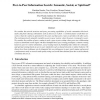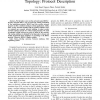128
Voted
MMNS
2004
15 years 2 months ago
2004
Existing multicast traffic engineering (TE) solutions tend to use explicit routing through MPLS tunnels. In this paper we shift away from this overlay approach and address the band...
113
Voted
ISCAPDCS
2004
15 years 2 months ago
2004
The dual-cube is a newly proposed interconnection network for linking a large amount of nodes with low node degree. It uses low-dimensional hypercubes as building blocks and keeps...
106
Voted
CATA
2003
15 years 2 months ago
2003
A number of routing protocols have been proposed for mobile ad hoc networks. In this paper we propose a hybrid multiple zoning scheme minimizing the number of route request messag...
101
Voted
SBBD
2007
15 years 2 months ago
2007
We consider the network structure and query processing capabilities of social communities like bookmarks and photo sharing communities such as del.icio.us or flickr. A common fea...
109
Voted
NIPS
2007
15 years 2 months ago
2007
We describe a neurobiologically plausible model to implement dynamic routing using the concept of neuronal communication through neuronal coherence. The model has a three-tier arc...
102
Voted
SODA
2008
ACM
15 years 2 months ago
2008
ACM
We consider the problem of minimizing average latency cost while obliviously routing traffic in a network with linear latency functions. This is roughly equivalent to minimizing t...
113
Voted
NETWORKING
2007
15 years 2 months ago
2007
We consider event dependent routing algorithms for on-line explicit source routing in MPLS networks. The proposed methods are based on load shared sequential routing in which load ...
109
Voted
RIVF
2008
15 years 2 months ago
2008
We introduce a new overlay network named ROSA1 . Overlay networks offer a way to bypass the routing constraints of the underlying network. ROSA used this overlay network property t...
103
click to vote
PEWASUN
2008
ACM
15 years 2 months ago
2008
ACM
In the design of many proactive routing protocols for MANETs, it is often assumed that topology information is disseminated instantly and error free. Exceptions include hazysighte...
94
Voted
OPODIS
2008
15 years 2 months ago
2008
We present a concurrent face routing CFR algorithm. We formally prove that the worst case latency of our algorithm is asymptotically optimal. Our simulation results demonstrate tha...



